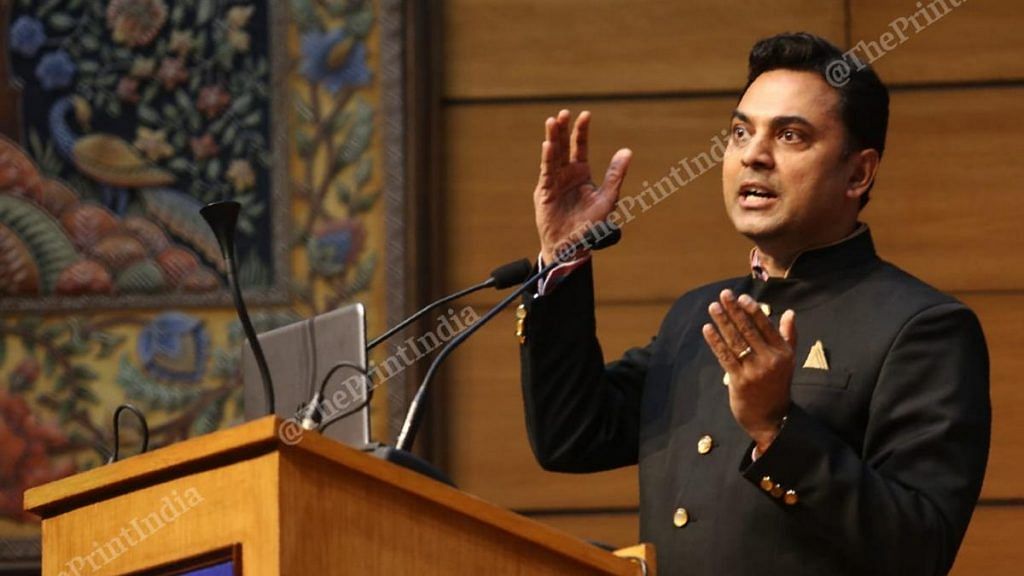New Delhi: At a glance, Chief Economic Adviser K.V. Subramanian’s first Economic Survey may look like a quasi-religious document and not the guide it’s meant to be.
References to Ardhanareshwar, an avatar of Lord Shiva, female scholars like Gargi and Maitreyi mentioned in the Rig Veda, Matsyanyaya, the rule of fish/jungle, and tax evasion and default as sins in Hinduism, Islam and Christianity, abound in the survey tabled in Parliament Thursday.
But Subramanian’s document draws heavily on mythology and religion to convey how deep-rooted religious beliefs can be used to bring in a change in society and elevate the role of women.
Making use of mythology
When he talks about tax evasion and defaults, Subramanian mentions the doctrine of pious obligation and how Hinduism, Islam and the Bible consider these as sins to advocate the use of behavioural economics to make people more compliant.
“In Hinduism, non-payment of debts is a sin and also a crime… Under Islam, Prophet Muhammad advocated — ‘Allaahummainnia’oodhibika min al-ma’thamwa’l-maghram (O Allaah, I seek refuge with You from sin and heavy debt)’… The Bible says, ‘Let no debt remain outstanding except the continuing debt to love one another,’” says the survey.
Subramanian goes on to liberally use mythology to represent the elevated role of women in ancient society.
“Ardhanareshwar — a half male-half female representation of Lord Shiva — captures the equality between men and women. The Rigveda identified many women sages as treasures of knowledge and foresight: the prophetess Gargi, who questioned the origin of all existence in her Vedic hymns and the great Maitreyi, who rejected half her husband’s wealth in favour of spiritual knowledge.
“The long philosophical conversations between sage Agasthya and his highly educated wife Lopamudra are legendary,” says the survey.
It adds that many popular men were identified with their mothers or wives and companions.
“Men in ancient Indian society were identified with their mothers, Yashoda-Nandan, Kaushalya-Nandan, Gandhari-Putra, as well as their wives/consorts, Janaki-Raman, Radha-Krishna.”
In his creative interpretations, the CEA also draws an equivalent between ending Matsyanyaya and filling up vacancies in lower courts and high courts to clear the backlog of cases.
Also read: ‘Nudge’ is the secret behind success of Modi’s pet projects, says Economic Survey
How Subramanian wants to bring about social change
The survey uses many interesting phrases and acronyms to effectively put across its point for the need for more economic and social reforms and a change in mindset across sectors.
Rivalling the terms coined by his predecessor Arvind Subramanian in his 4 economic surveys in the last four fiscals, the CEA’s document uses terms like ‘Badlav’, ‘Sundar Bharat’ and ‘nourishing dwarfs to become giants’.
Subramanian suggests moving from ‘Beti Bachao Beti Padhao’ to ‘BADLAV’, or ‘Beti Aapki Dhan Lakshmi Aur Vijay Lakshmi’, as part of the ambitious agenda for social change for emancipation of women.
He also advocates moving from ‘Swachh Bharat’ to ‘Sundar Bharat’ for a more hygienic country, and from a ‘Give it up’ stance for the LPG subsidy to ‘Think about the Subsidy’ position.
On the issue of removing incentives that encourage micro, small and medium enterprise to stay small, the CEA pushes for the need to “nourish dwarfs to become giants” by doing away with size based incentives that encourage these firms to not increase their size.
In his economic surveys between 2014-15 and 2017-18, some of the interesting acronyms coined by former CEA Arvind Subramanian included the ‘4Rs’ (2015-16 survey) — Recognition, Recapitalisation, Resolution, and Reform — to resolve the twin balance sheet problem, and the JAM trinity (2014-15 survey) — Jan Dhan Yojana, Aadhaar and mobile number — to ensure targeted delivery of subsidies.
Also read: Cut court holidays — now even Economic Survey wants higher judiciary to work more
